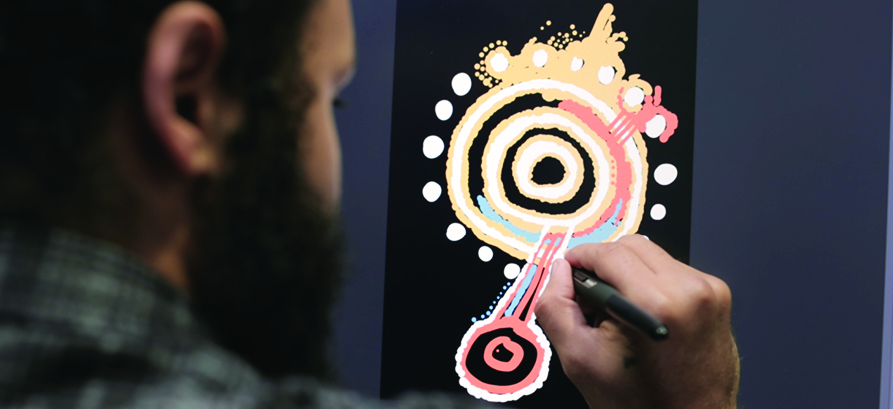When it comes to delivering the key concepts of the Aboriginal and Torres Strait Islander Histories and Cultures curriculum some primary school teachers are unsure of where to start. What is the best approach? What is culturally appropriate?
By following these six steps from The Song Room’s First Nations Teaching Artists, you will have a greater understanding of what’s required to bring cultural learning into your classroom with respect and sensitivity. Plus, you and your students will be given the opportunity for deeper cultural learning and connection.
1. Be an inquirer
Create a culture of respectful curiosity in your classroom. Model an inquiry approach and demonstrate how to ask thoughtful questions, respectfully engage community members and access quality resources in your learning community. You don’t have to have all the answers. Instead, learn with your students by creating time and space for listening, connecting and reflecting on diverse perspectives together.
“There has been a long period in our history, in which the inclusion of Aboriginal voices and knowledge were omitted from the general public and education system. So, it is now so important, and highly appreciated, when people engage with our cultures and learn about our shared history. Our cultures are so rich and we have so much to share.”
Rickeeta Walley | The Song Room Teaching Artist
2. Connect to Country
First Nations peoples have much to teach students about sustainability and caring for Country. Encourage your students and colleagues to connect with the Country they live, learn and work upon. Find out about the seasons on your Country and plant native gardens upon the advice of local Elders of First Nations community groups.
Create artworks in nature (without disturbing plants and animals!). This could include drawing in sand, making sculptures from fallen sticks and leaves or making mandalas with stones and fallen flowers.
“Connection to Country is our belonging, we care for Country, we don’t own Country, Country owns us. In our hearts it’s very sacred, we are the caretakers. Everything about Country is very important – following nature, knowing the six seasons, what is abundant, what is to be left alone.”
Marcelle Riley | The Song Room Teaching Artist
3. Acknowledge Country
An Acknowledgement of Country is an act of respect and recognition for the Traditional Owners and Custodians of the land on which your school sits. Encourage your students and colleagues to think about what it means to acknowledge Country and invite them to create their own personal acknowledgments that can be shared at the start of the school day, in meetings and at events throughout the year.
“It’s really important to understand why we do an Acknowledgement of Country. This was Aboriginal land first so an acknowledgment is a sign of respect. If we teach kids the reason why it’s done, they grow up understanding it and can let other people know.”
Merinda Hansen | Noongar Language Teacher

4. Keep language alive
Australia has more than 250 Indigenous languages including 800 dialects, specific to a particular place and people. More than 90% of these languages are considered endangered. Make every effort to learn about the First Nations languages in your area.
Consider ways that you can help preserve, strengthen and acknowledge First Nations languages. This could include updating signage in your school, employing a First Nations language teacher, creating a school Acknowledgement song with a local community member and embedding First Nations words into your classroom practice (e.g. using numbers or animal words for class/house groups).
“I encourage all young people to learn the language from the Country that they are on. Language is part of culture, it’s our DNA, our ancestry. If children learn dance and language and ceremony they will soon find themselves – their whole selves.”
Della Rae Morrison | The Song Room Teaching Artist
5. Lift up First Nations voices
Listen and connect with First Nations people in your school and local community. Non-Indigenous people do not have authority to speak about certain aspects of Aboriginal and Torres Strait Islander histories and cultures, and cannot speak for or about the experiences of First Nations people.
Include resources in your curriculum and learning environment that introduce students to First Nations voices through culturally appropriate books, artwork, videos and music. Invite parents, community members and local Elders into your classroom to lead learning and seek their advice to create culturally safe and appropriate learning.
“The best way to do it is to have Aboriginal or Torres Strait Islander people lead the work because cultural knowledge is best used in our hands. There are much deeper cultural and economic factors that non-indigenous people encroach on when creating this type of content.”
Tyrown Waigana | The Song Room Teaching Artist
6. Share stories and walk together
Respect the stories of your community members and create opportunities to yarn and walk together. Be an ally and encourage your school to create a Reconciliation Action Plan. Help your school community to develop inclusive policies and whole-school approaches that are culturally responsive and respectful.
This could include: whole school celebrations for NAIDOC and Reconciliation weeks, cultural competency training for parents and staff, displaying Aboriginal and Torres Strait Islander flags, ensuring First Nations people are represented on school committees and school garden projects that promote caring for Country.
“Respect that everyone has their own story, their own connection to land, connection to family and community. Storytelling is important because you feel like it’s something that belongs to you – it’s your story. You can go anywhere. You share with others, and they will share their story.”
Yolande Yarren-Ward | The Song Room Teaching Artist
The Deadly Arts Collection
![]()
Bring First Nations culture and learning into your classroom with the Deadly Arts collection on ARTS:LIVE.
The courses are led by First Nations Teaching Artists from The Song Room to help teachers and students explore concepts of country, culture and people though the arts. The collection includes videos, lesson plans, activity sheets and tips for culturally responsive teaching.


